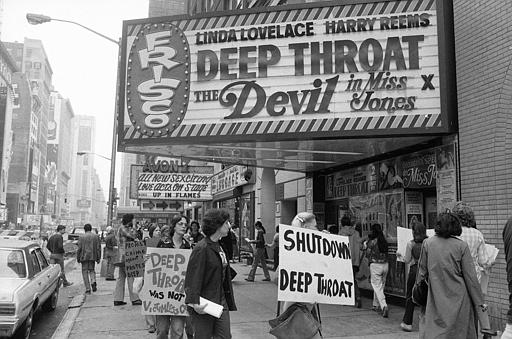Deep Throat (1972), arguably the most famous pornographic film, introduced mainstream society to pornography, made millions of dollars, and was banned as obscene in 23 states.
Lower courts said Deep Throat was obscene
When released in 1972, the 62-minute film—featuring actress Linda Lovelace performing oral sexual acts on several male actors—generated a great deal of controversy. Prosecutors across the country brought obscenity charges against theater owners who showed the film. Many lower courts determined that the film constituted obscenity.
For example, in 1973 in United States v. One Reel of Film, the 1st U.S. Circuit Court of Appeals described Deep Throat as “a film so single-minded as to fail even the older Roth-Memoirs test [which required a work to be “utterly without any redeeming social value” to be obscene]—unless one is tempted, as plainly a majority of the Supreme Court is not, to find redeeming social value in the explicit portrayal, without more, of sexual congress itself.”
In 1973, in People v. Mature Enterprises, New York criminal trial court judge Joel J. Tyler ruled the film obscene, calling it a “feast of carrion of squalor” and “a Sodom and Gomorrah gone wild before the fire.”
Actor, producers convicted for obscenity and conspiracy
The primary male actor in the film, Herbert Streicher (whose stage name was Harry Reems), faced obscenity charges in Memphis, Tennessee, for his participation in the movie. A jury convicted him in March 1976, but an appeals court overturned the conviction in 1977. Those lengthy legal proceedings also resulted in convictions for the film’s producers Louis Peraino, Anthony Battista, and others for transporting (showing) the allegedly obscene film in interstate commerce and conspiracy to violate obscenity laws.
The Supreme Court denied review of these cases in Peraino v. United States (1981) and Armone v. United States (1988).
Linda Lovelace (Marchiano) later became a spokesperson against pornography and published a book accusing her first husband, Chuck Traynor, of pressuring her to perform unwanted sexual activity in the pornography industry. She died in 2002 from injuries sustained in an automobile accident.
In the early 1970s, Bob Woodward and Carl Bernstein used the name “Deep Throat” to hide the identity of one of their most important sources in their award-winning Watergate investigations for the Washington Post.
David L. Hudson, Jr. is a law professor at Belmont who publishes widely on First Amendment topics. He is the author of a 12-lecture audio course on the First Amendment entitled Freedom of Speech: Understanding the First Amendment (Now You Know Media, 2018). He also is the author of many First Amendment books, including The First Amendment: Freedom of Speech (Thomson Reuters, 2012) and Freedom of Speech: Documents Decoded (ABC-CLIO, 2017). This article was originally published in 2009.

